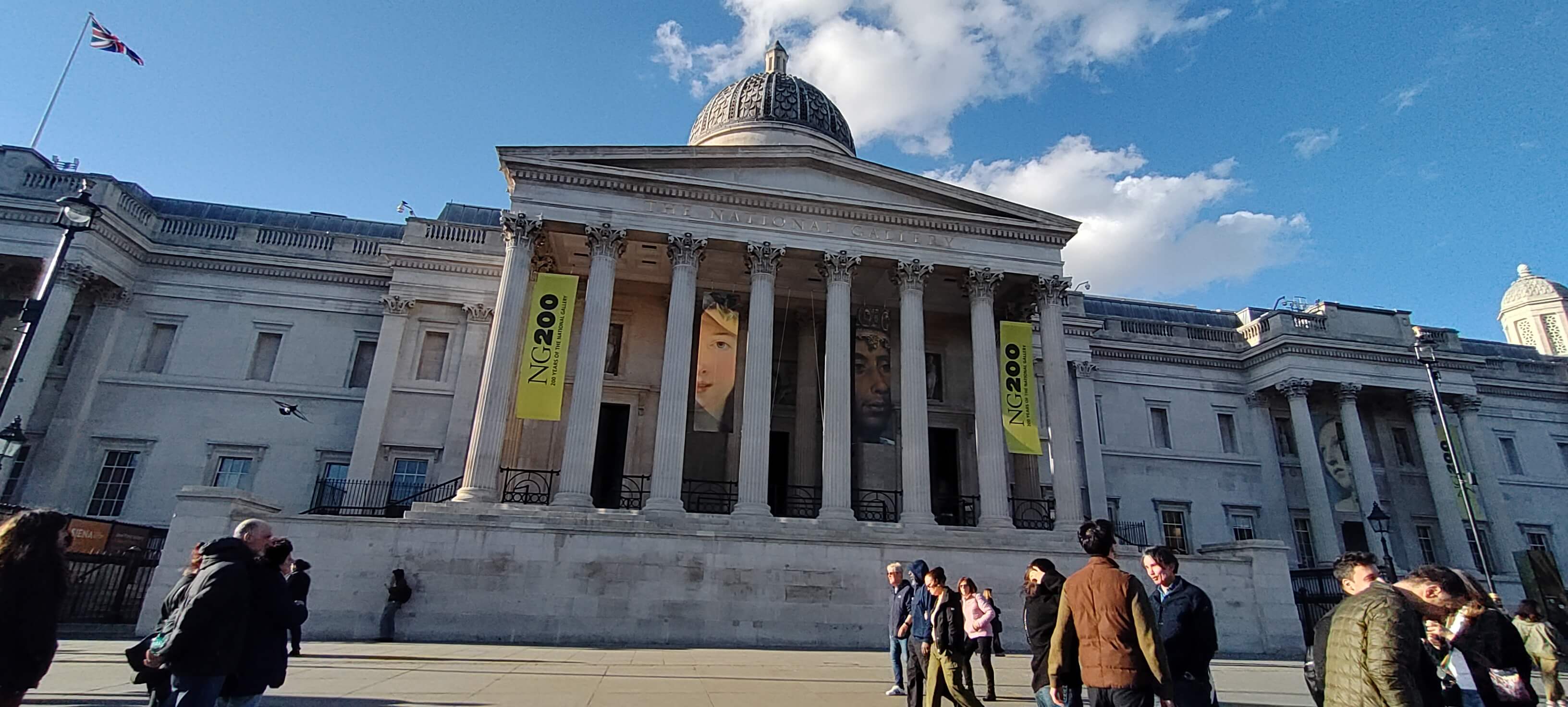
LINE DIALOGUES: Encounters with Portraiture
1. Imagining Kinship with Painted Figures
Have you ever felt like you would like to have a dialogue with people in historical paintings?
I sure have. As a dancer I have often felt like I should be moving with the people in the paintings, or I have imagined being in the situation of the painting and thought about the sensations and movement in my body that situation would bring up. I often find myself glorifying the old days because of the image the old artworks give from those days. Then remembering how the life painted was that of the upper class, I find it hard to relate to. To find a common ground with the people of the paintings I rely back on embodiment. I observe, analyse and mimic the postures and gestures of the people and imaging how they move in their clothes. The living conditions, political and world orders might have changed but we still entertain a similar body with similar functions as the ones in the paintings. This creates a meeting point between bodies, one living and material and the other one archived, visual representation of something that used to be living and material. Shared physical limitations of the human body becomes a point of connection, creating a sense of inclusion. Bridging the past and present together through embodiment serves as a form of reclaiming history, making it accessible for all modern bodies to experience, regardless age, gender, social or economical status.
What happens when you don't just passively look at a painting, but you connect with it through your body? Can you create a bridge through history by physically inhabiting the gestures and postures of paintings? And can you experience a museum not as a place of stillness, but a place of shared presence and rhythm?
These are the core questions driving the project proposal ‘Line Dialogues: Embodied encounters with portraiture’ developed for the Central Hall of the National Gallery in London. The project brings together embodied interpretation, heritage through movement, and the joy of collective dance - offering a new way to relate to visual art. In Line Dialogues, participants are invited to learn a looped line dance based on the postures and gestures of the ten portraits, painted between 1555 and 1902, hanging in the National Gallery’s Central Hall. The movements in the dance mirrors directly the stances and embodied expressions of the portraits. Moving from Lord Ribblesdale’s swagger to the elegance of Eva Gonzales, and the contemplative lean of Don Justino de Neve.
The following four posts explore the proposed project through different perspectives: theoretical, choreographic, logistical and reflective. Rather than offering fixed answers I am to raise questions and open up possibilities.
2. Moving Through Time: Dance as a Connection, Resistance and Interpretation
Michael Baxandall discusses in his book The Period Eye(1988) how painters through time have painted in details that attract the people of their time, and how we as people of today can never have the same experience with the paintings as the people of the time of the creation. My question is if we relate to historical paintings through our contemporary set of filters, what possibilities do we have?
I believe strongly that through embodied practices like dancing, we can create relationships beyond the present times.
Why line dance, and why now?
Research shows that dancing in synchrony builds solidarity, collectiveness, and even raises our pain threshold(Tarr, Launay, Dunbar, 2016). This project proposal is grounded in the theory of participatory sense-making (De Jaegher & Di Paolo, 2007), where meaning emerges not solely from individual minds, but from embodied interaction. In a world marked by fragmentation, fear, and digital disconnection, dancing together becomes a radical act of making sense with others. We co-create a shared rhythm, a felt connection, and a fleeting moment of solidarity. A gesture of resistance and belonging made not through speech, but through motion.
Line dance has its roots in Afro-diasporic, and marginalized disco and funk communities in the USA. Disco music, and line dance with it, grew popularity through the 1970s, and gained mainstream visibility especially following the popularity of Saturday Night Fever starring John Travolta. Emerging from communities facing systemic oppression, disco was a joyful form of resistance to the political and societal tensions of the early 1970s.(PBS,2023) To use disco music and line dance to engage with history is to practice subtle protest and embodied solidarity.
Dancing with and for paintings, Line Dialogues bridges what UNESCO defines as tangible and intangible heritage, bringing movement into conversation with historical art. Using the postures and gestures of the painted figures as a choreographic source material reframes embodiment as a tool of heritage interpretation. Professor of performance studies, Diana Taylor argues, that embodied practices, such as movement and gestures, functions as form of knowledge and carry historical memory.(2003)
Why the National Gallery?
The National Gallery has throughout its history been a place for resistance, for protest and people asking for connection. As early as in 1914 Velázquez's Rokeby Venus was damaged by Mary Richardson, a campaigner for women's suffrage, in protest against the arrest of Emmeline Pankhurst the previous day. In July 1987 Robert Cambridge shot Leonardo's cartoon of The Virgin and Child with Saint Anne and Saint John the Baptist, and told police that his intent had been to express his disgust with "political, social and economic conditions in Britain". Latest activism in the Gallery include Just Stop Oil activists attacking Vincent van Gogh's Sunflowers in October 2022 and the Rokeby Venus in November 2023. In october 2024 demonstrators pasted a photo of a Gazan mother and child over the glass of Picasso’s 1901 painting ‘Motherhood (La Maternité) in a protest over arms sales to Israel.
In this context, Line Dialogues propose a form of soft activism through disco line dancing, gently resisting the dominant museum norms by challenging the Western gaze, and expanding the etiquette of still observation. The National Gallery with its layered history is an ideal place for this.
3. Choreographing Connection: The Line Dance
This line dance is based on mirroring postures from the ten paintings in the Central Hall of the National Gallery. The sequence of movements follows the physical order of the paintings, from right to left when entering the hall. This loosely traces a chronological arc from the newest to the oldest painting. The sequence is designed to repeat continuously and change facing direction after each loop, like in common four wall line dances. It takes up little space, uses controlled gestures, and invites participation across levels.
The choreography suits all movers, levels and engagement. You can adjust it for yourself by choosing to do only the feet or arms, and leaving out head movements. The choreography is not meant to be mastered, but explored and enjoyed.
The choreography is a 4x8 count loop to be repeated throughout the whole song.
The soundtrack for the dance is "Love Is the Message" (Love groove bonus) by MFSB.
Movements and paintings of the choreography:
1. Lord Ribblesdale
Painting by: John Singer Sargent (1902)

Step first with the left foot next to the right foot, then step right foot front pushing hip to the right side, step back with left foot swaying hip to the left then repeat step to the front with right foot and right hip.
counts: 1-2-3-4
2. Louis-Auguste Schwiter
Painting by: Eugène Delacroix (1826–1830)
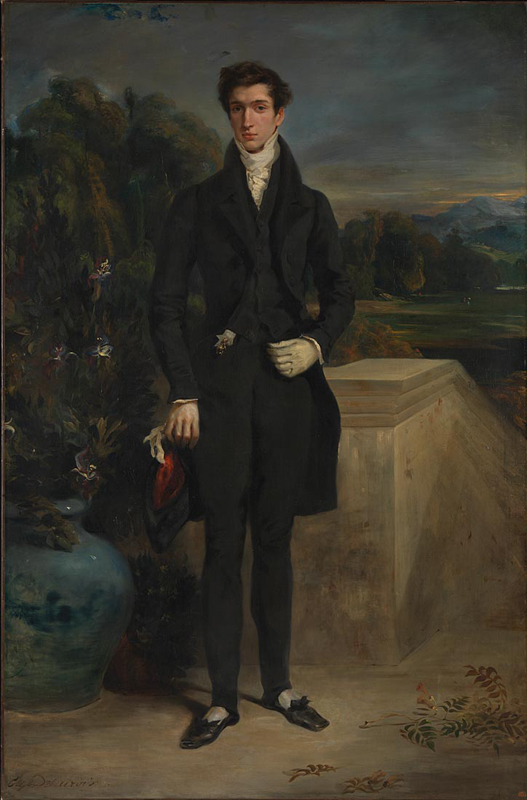 Bring your left foot to the front, then to the side and finally to the back, while the hands are pumping. From having arms straight next to your legs, the left one stretches down in sync with the leg and the right hand comes up to the hip.
Bring your left foot to the front, then to the side and finally to the back, while the hands are pumping. From having arms straight next to your legs, the left one stretches down in sync with the leg and the right hand comes up to the hip. counts: 5-6-7
3. Charles William Lambton (The Red Boy)
Painting by: Sir Thomas Lawrence (1825)

Lift the left foot behind the right knee, opening the left knee to the side, while raising the right palm open to the right ear and left arm stretched to the left lower diagonal. Bring gaze to the left upper corner.
count: 8
4. The Marquise de Seignelay and Her Sons
Painting by: Pierre Mignard (1691)
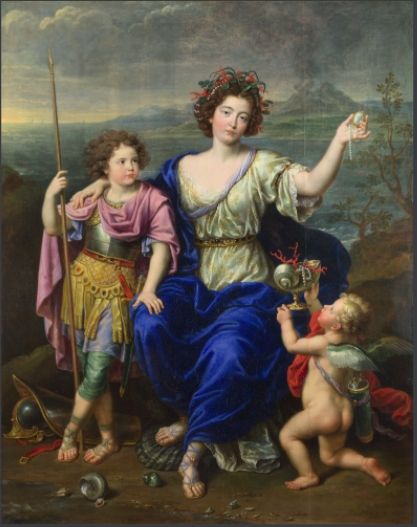 a) Marquise
a) Marquise Step left leg to the back bringing right foot to tap next to left foot and step right foot to the front and tap left foot next to right foot, and repeat stepping left foot back and tapping right foot next to left foot, all while spreading arms to the sides, left palm facing down and right palm up, and alternating shoulders left to the front while right to the back and vice versa.
counts: 1-2-3-4-5-6
b) Her son
Step right leg cross in front of the left foot and turn to the left bringing legs together. Simultaneously with crossing right leg bring left hand next to left shoulder (elbow down) and right hand straight next to right leg with flex wrist.
counts: 7-8
5. Eva Gonzalès
Painting by: Édouard Manet (1870)
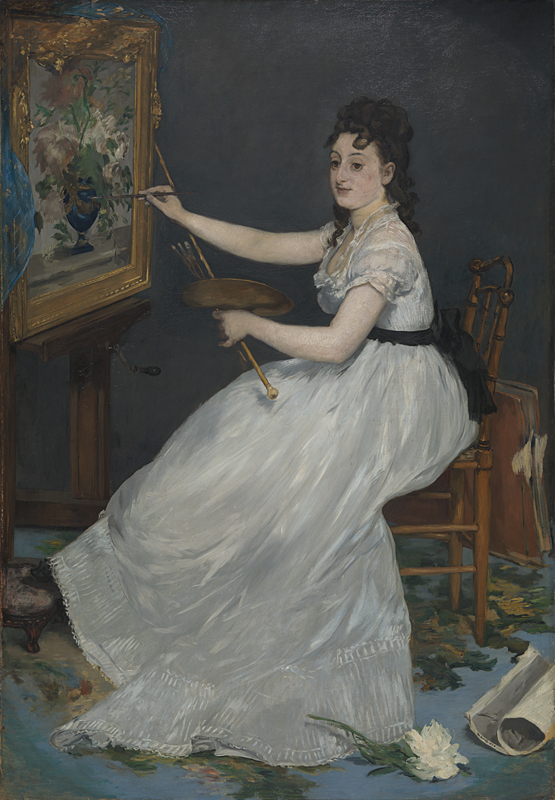 In a painting motion, slowly bring the left arm up in front and right hand down to hip level, repeat the other side with the right arm up and left arm down, and one more time with the left arm up and right down.
In a painting motion, slowly bring the left arm up in front and right hand down to hip level, repeat the other side with the right arm up and left arm down, and one more time with the left arm up and right down.counts: 1-2-3-4-5-6
6. Madame de Pompadour
Painting by: François-Hubert Drouais (1763–64)
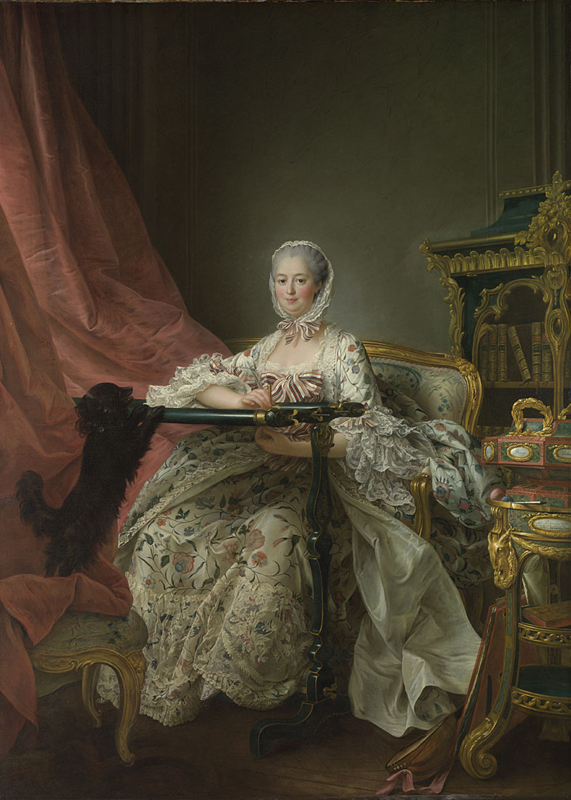 While pinching your fingers together, bring left and right hand fingers to touch in front of the centre of your body, elbows facing outwards, and then pull hands separate by lifting left hand and lowering right hand while gradually opening the palms.
While pinching your fingers together, bring left and right hand fingers to touch in front of the centre of your body, elbows facing outwards, and then pull hands separate by lifting left hand and lowering right hand while gradually opening the palms. counts: 7-8
7. Elizabeth Stuart, Queen of Bohemia
Painting by: Gerrit van Honthorst (1642)
 Step front with right foot while bringing right arm to the front, then step back to left foot and continue with stepping back with right foot while bringing left arm to the front, and make a ball change (small step with left and right foot) while turning to the right and bring left foot next to right foot.
Step front with right foot while bringing right arm to the front, then step back to left foot and continue with stepping back with right foot while bringing left arm to the front, and make a ball change (small step with left and right foot) while turning to the right and bring left foot next to right foot. counts: 1-2-3-and-4-5
8. Don Justino de Neve
Painting by: Bartolomé Esteban Murillo (1665)
 Bend knees and lean upper torso forward while bending the elbows close to 90 degrees, straighten knees and bring torso back up, then repeat bend knees and lean forward one more time.
Bend knees and lean upper torso forward while bending the elbows close to 90 degrees, straighten knees and bring torso back up, then repeat bend knees and lean forward one more time. counts: 6-7-8
9. Gentleman of the Soranzo Family
Painting by: Paolo Veronese (1585)
 Stretch out the left leg to the front diagonal while leaning back with your torso and gazing to the left down diagonal. Then stretch your left leg to the back and turn your body back 180 degrees and step your right foot together.
Stretch out the left leg to the front diagonal while leaning back with your torso and gazing to the left down diagonal. Then stretch your left leg to the back and turn your body back 180 degrees and step your right foot together.counts: 1-2-3-4
10. Portrait of a Gentleman (with sword)
Painting by: Giovanni Battista Moroni (c. 1555–56)
 Tap with the left foot to the front while bringing up the left arm in 90 degree angle, hand head level, keeping right hand navel level and twist hands from wrists inwards, repeat the twist and tap three more times. Look simultaneously to the right.
Tap with the left foot to the front while bringing up the left arm in 90 degree angle, hand head level, keeping right hand navel level and twist hands from wrists inwards, repeat the twist and tap three more times. Look simultaneously to the right. counts: 5-6-7-8
Check out the Line Dialogues Choreography Tutorial Video Here
Read more about the paintings
Note: As of May 2025, the first two paintings, Lord Ribblesdale by John Singer Sargent and Louis-Auguste Schwiter by Eugène Delacroix, were replaced with portraits of King Charles III and Queen Camilla. This change highlights the living, shifting nature of museum curation and possibilities for choreography revision over time.
4. Behind the Scenes: The Invisible Work of Dance
The idea for Line Dialogues began with a feeling when visiting the National Gallery the first time. I sensed that the still portraits in the National Gallery’s Central Hall were calling for interaction. But bringing these kinds of ideas into reality demands much more than imagination. It demands careful negotiation of space, logistics, safety, and, sometimes, resilience against institutional limits.
Planning a project as a freelance dance artist requires one to balance multiple different roles: choreographer, performer, facilitator, producer, and researcher. Usually all at once. As the National Gallery’s Central Hall became the chosen place for the proposal, I needed to know more about the Hall and went to visit again. Museums are carefully regulated environments, where sound and movement is controlled to protect valuable artwork. Knowing the etiquette and limits is essential when making embodied practice project proposals.
So, after planning the choreography at home, I returned to the National Gallery to observe the Central Hall in detail. I arrived a little over an hour before closing time, joining the entrance queue on the side of Trafalgar Square. Most visitors seemed to be tourists: families, couples, friends, though a few, like me, arrived alone. Entering the Gallery through a metal detector, I noticed the careful regulation of bodies at the threshold. The security team was guiding larger bags for inspection, channeling smaller ones through.
From the entrance, a flight of stairs leads directly up to the doors of the Central Hall. Inside, four benches form a rectangle of roughly 5x3 meters in the middle of the room, an ideal space for the line dance to be performed. I sat on one of the benches observing the room, and noticed the Hall’s high ceilings with the natural light filtering through glass window panes. The Hall, situated in the middle of the museum, serves as a welcoming crossroad where people can choose their own path to explore the museum by choosing one of the four directions.
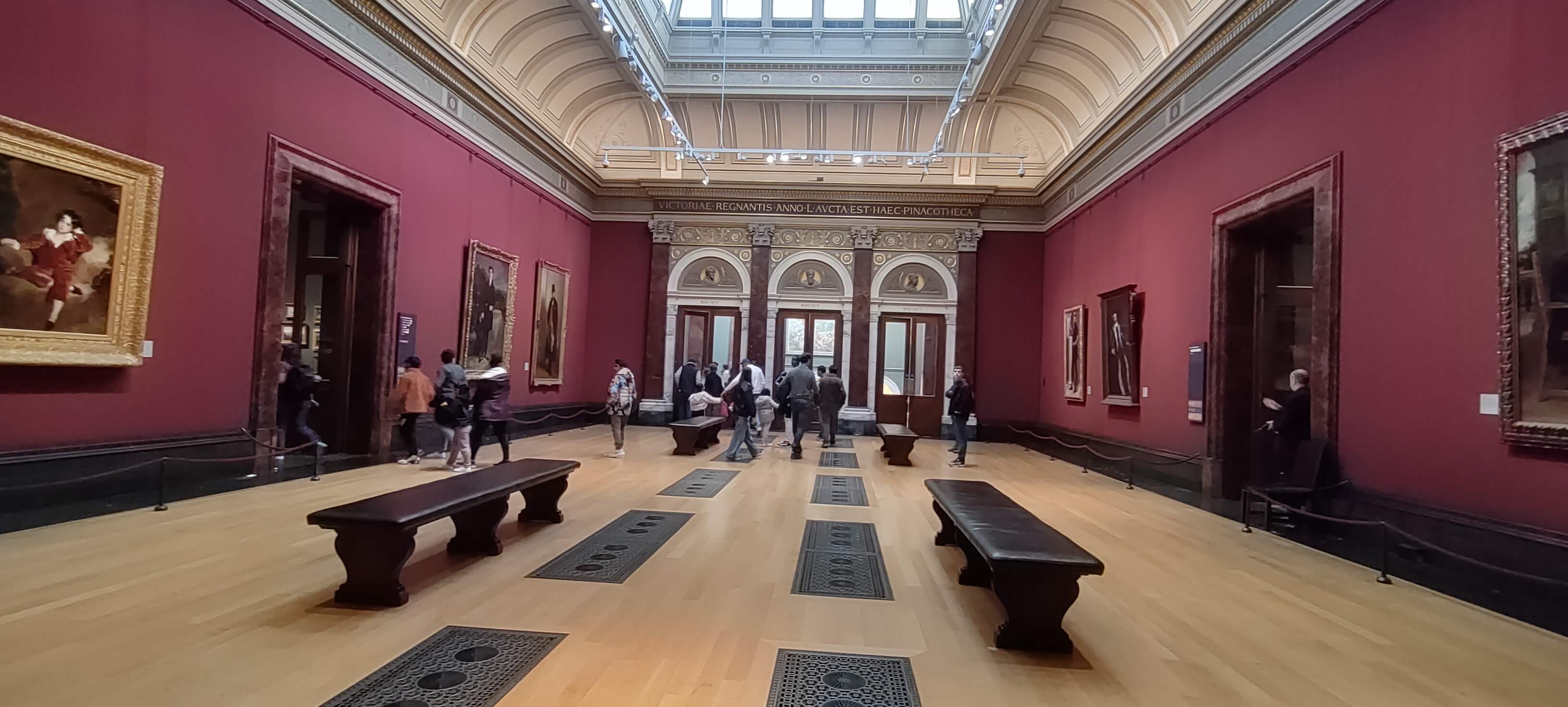
After a moment of people watching, I dive in deeper to focus on the ten paintings, and put on my earphones. I play Love Is the Message (Love groove bonus) by MFSB, a newer version of the 1973 disco track rooted in communal celebration. As the music filled my ears, I marked through the choreography quietly, imagining how the sequence danced by more people would fill the space. Facing each wall of the Hall, I turned with the dance, aligning the gestures and creating interplay with the paintings that hung there.
The feeling was immediate: an embodied conversation with the art. Moving from painting to painting, observing, mirroring postures, step-by-step, I experienced the reciprocity described by theories of participatory sense-making. I started to see the figures in the paintings jam to the music in their own way, the textiles in the portraits seemed almost to ripple. Movement filled the paintings with life, while their richness and history fed back into my dance. It was not about reenactment, it was about co-creation, across centuries.
Still, planning a public event in a museum means working with more than just inspiration. After my quiet rehearsal, I approached a gallery assistant asking about the Hall’s history. He said it was part of the Gallery’s original 19th-century building. When I asked about playing music, he confirmed that concerts had been held in the Hall, but warned about sound levels, as excessive vibration could endanger the paintings. I was advised to consult the building managers for detailed information. Thus, I explained my imagined project to a friendly visitor services assistant at the membership desk, and received a general email address. She said my message would be forwarded to the right department. With excitement I left the museum, and as I got home I sent an email with clarifying questions.
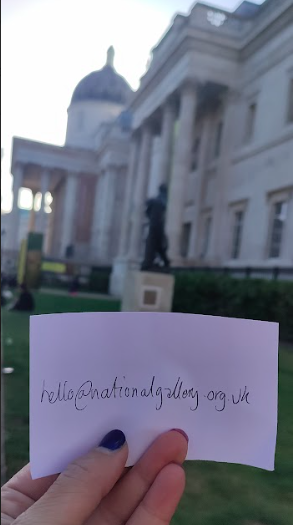 Next day I was reminded of the realities many freelance dance artists face. Despite polite outreach, I was told the museum could not directly assist Master's level students due to the volume of inquiries. I then remembered, and understood why the museum assistant on site suggested emailing different departments and advised patience. While a little disheartening, these interactions are part of the invisible labor of planning live work: multiple conversations, dead-ends, and re-imaginings.
Next day I was reminded of the realities many freelance dance artists face. Despite polite outreach, I was told the museum could not directly assist Master's level students due to the volume of inquiries. I then remembered, and understood why the museum assistant on site suggested emailing different departments and advised patience. While a little disheartening, these interactions are part of the invisible labor of planning live work: multiple conversations, dead-ends, and re-imaginings.Planning Line Dialogues is itself an act of soft resistance. An insistence that embodied, collective joy belongs even in the most formal spaces. That negotiation with space, with institution, with history is not separate from the dance. It is a part of it.
5. Inviting Movement: Proposal, Possibilities and Public Access
Final proposal:
As a part of the National Gallery’s Friday Late Series, Line Dialogues proposes two small performances and two workshop performances, based on mirroring the postures and gestures from the ten historic portraits in the space. The two short performances give people a chance to see and observe the paintings in the movements, and the two workshop performances allow them to embody and create dialogues, with the art in the space, through shared movement.
Proposed schedule of events:
6:30 PM - Short performance (2,5-3min) with four dancers, exhibiting the line dance. Ending with invitation to join the participatory mini-workshop later
6:45 PM - Repeat of the short performance and invitation
7:00 PM - Participatory mini-workshop (15-20min) where audience members learn the dance, and perform it together
7:30 PM - Repeat of the mini-workshop
Audience members who want to join are invited inside the rectangle in the middle of the Central Hall. The four performers/facilitators stay outside the rectangle, one on each side to keep control of the space and act as a frontman when the dance changes direction.
Budget:
4 dancers/Facilitators (including performance and short rehearsal) 4x250 1000
Admin, planning and coordination 150
Silent headphone rental (if used) 250
Contingency 100
Total 1500
Potential funding and support:
If the National Gallery cannot provide full funding, additional support could be sought from:
Arts Council England - National Lottery Project Grants (focus on public engagement and heritage innovation)
Heritage Fund (National Lottery) for participatory reinterpretations of heritage
Line Dialogues is not just Line Dance but is an opening to a new way of connecting to visual and historical art. In place of stillness and observation, Line Dialogues offers rhythm, communal sensing, and relationality. By moving with and for art instead of just around it, participants create new ways of being together in public space.
In many ways, this proposal echoes the questions raised by Arabella Stanger(2016) in her review of Boris Charmatz: If Tate Modern was Musée de la danse:
"If Charmatz’s If Tate Modern carries with it an implicit set of invitations not only to watch dance but also to dance, then what are the cultural and institutional policing mechanisms that must be negotiated for these invitations to be accepted?"
In the National Gallery, this project tests what happens when such invitations are made explicit and accessible. By teaching the dance and offering structured support, the project aims to offer a safe and inclusive frame for participation.
It is easy to speculate that one posture and gesture at the time we would make history live again through our bodies and feel communal joy doing that. However, as Sara Wookey reflected on Dancing Museums by Lucy Suggate(2016), participation does not automatically equal connection. Sometimes it produces distance or confusion. Line Dialogues acknowledges this. It doesn't promise euphoric unity, but it does propose presence, and the chance to share a frame of attention through the body.
Line Dialogues do not end with the performances. With access to the choreography guide and video, anyone can visit the Central Hall and mark the dance in their own way. More importantly, the idea invites people to get inspired. To put on their own music, wander around the museum, and imagine meeting the figures of the paintings not in silence, but through embodied interaction on a vibrant dance floor.
Bibliography
Arts Council England (n.d.) National Lottery Project Grants. Available at: https://www.artscouncil.org.uk/projectgrants (Accessed: 4 May 2025).
Baxandall, M. (1988) Painting and Experience in Fifteenth Century Italy: A Primer in the Social History of Pictorial Style. Oxford: Oxford University Press.
Brown, M. (2022). Van Gogh’s Sunflowers covered in tomato soup by eco-activists. The Art Newspaper, [online] 14 Oct. Available at: https://www.theartnewspaper.com/2022/10/14/van-goghs-sunflowers-covered-in-tomato-soup-by-eco-activists [Accessed 3 May 2025].
De Jaegher, H. and Di Paolo, E. (2007) ‘Participatory sense-making’, Phenomenology and the Cognitive Sciences, 6(4), pp. 485–507. doi:10.1007/s11097-007-9076-9.
PBS (2023) Disco: Soundtrack of a Revolution [Docuseries]. Available at: https://www.pbs.org/show/disco-soundtrack-of-a-revolution/ (Accessed: 4 May 2025).
Harrison, E. (2023). Just Stop Oil activists glue themselves to National Gallery painting in latest climate protest. The Independent, [online] 6 Nov. Available at: https://www.independent.co.uk/arts-entertainment/art/news/just-stop-oil-national-gallery-painting-b2442404.html [Accessed 4 May 2025].
Heritage Fund (2023) What we fund | The National Lottery Heritage Fund. Available at: https://www.heritagefund.org.uk/funding/what-we-fund (Accessed: 4 May 2025).
National Gallery (n.d.) Central Hall Paintings. Available at: https://www.nationalgallery.org.uk/visiting/floorplans/level-2/central-hall (Accessed: 4 May 2025).
Spalding, F. (1998). The Tate: A History. London: Tate Gallery Publishing.
Stanger, A. (2016) ‘Unauthorized Performance in the Turbine Hall’, caa.reviews. Available at: http://www.caareviews.org/reviews/2962 (Accessed: 4 May 2025).
Tarr, B., Launay, J. and Dunbar, R.I.M. (2016) ‘Silent disco: dancing in synchrony leads to elevated pain thresholds and social closeness’, Evolution and Human Behavior, 37(5), pp. 343–349. doi:10.1016/j.evolhumbehav.2016.02.004.
Taylor, D. (2003) The Archive and the Repertoire: Performing Cultural Memory in the Americas. Durham: Duke University Press.
Vogel, C. (1988). Restoring a Leonardo Drawing That Was Hit by a Shotgun Blast. The New York Times, [online] 8 Nov. Available at: https://www.nytimes.com/1988/11/08/arts/restoring-a-leonardo-drawing-that-was-hit-by-a-shotgun-blast.html [Accessed 3 May 2025].
Wookey, S. (2016) ‘Dancing Museums at National Gallery’, Wookey Works. Available at: https://sarawookey.com/dancing-museums-at-national-gallery/ (Accessed: 4 May 2025).
Note: As of May 2025, the first two paintings, Lord Ribblesdale by John Singer Sargent and Louis-Auguste Schwiter by Eugène Delacroix, were replaced with portraits of King Charles III and Queen Camilla. This change highlights the living, shifting nature of museum curation and raises new questions about tradition, representation, and national identity.